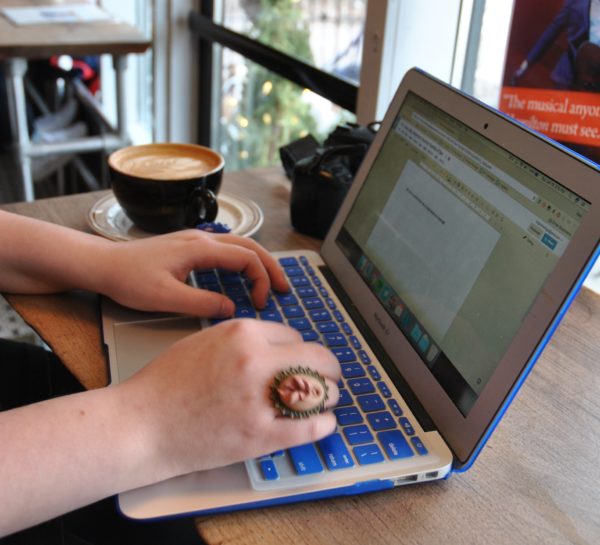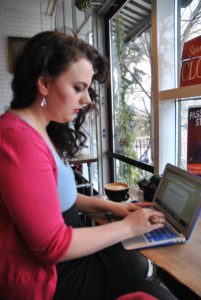
“I have cyclothymia,” a friend casually mentioned over dinner, halfway through an anecdote about his therapist. “It’s sort of like a milder form of bipolar disorder. I have mild manic phases and mild depressions but nothing too serious.”
It would be a cliché to say a lightbulb went off for me, or alarm bells sounded in my head, but both of those well-trod metaphors feel entirely true. I had a ping of recognition. A sudden, crystalline revelation: That is what I have. That is why I’m like this.
I didn’t quiz my friend for additional details, but in a therapist’s office a few months later, I dropped the word on the table between us like it was a treat I’d brought him. Cyclothymia. We examined it, talked about it. I explained how my storied life had been punctuated with depressive spells, yes, but also episodes of unpredictable juicy joy. When previous therapists witnessed my gleeful, giggly monologues, they’d often say, “Is it possible you’re having a manic episode right now?” and I’d always laugh it off. This isn’t a mental disorder, I’d think, about those hyper-productive, ecstatic interludes. This is just my personality. I’m a happy, positive person.
In the years since then, though – and in the wake of two recent therapists who can’t agree on whether I have cyclothymia or bipolar affective disorder, type 2 – I’ve come to accept that these ups and downs are part of my personality and are also a mental illness.They’re a part of me, and I try to honor them more than hate them. They make my life harder, my emotions wilder, and my art better.
Blogging and journalism, my main vocations, appeal to me in part because they’re compatible with my mental illnesses. As an independent freelancer, I can set my own schedule, and arrange my obligations according to where my head’s at. Of course, sometimes a deadline unavoidably lines up with a depressive spell, but I do my best to avoid snafus like this. Below are some productivity tricks I’ve picked up from nearly five years of blogging while bipolar… for better or for worse.
Drink up from the rain, as Nellie McKay would say (or “catch water while it’s raining,” like my friend Brent says). When I’m manic*, I often want to work for 10-12 hours at a time, writing blog posts/sending emails/pitching stories/cleaning my room/whatever – and while that’s a long stretch to put my body and mind through, usually manic-me can handle it without complaint. So as long as I’ve still got the energy and desire to continue, I usually do. Might as well.
*I’m using the words “manic/mania” interchangeably with “hypomanic/hypomania” in this article for brevity’s sake, even though technically my mental illnesses are mild enough that my hypomania never crosses into full-blown mania. More on this distinction here.
Queue stuff in advance. After a manic episode, I’ll typically have more content than I know what to do with: two or three days of hypomania can easily yield five or six blog posts for me. While mania can imbue you with an urgent need to get your work in front of readers’ eyes ASAP because it’s all so damn exciting, it’s smarter to rein yourself in and queue up some of that content for the days, weeks or months to come.
I publish new posts on this blog twice a week, and that steady schedule is super helpful to my bipolar brain. I use the WordPress Editorial Calendar plugin to map out my future content. I’ll slot in two posts a week, and rearrange them so there’s enough variation in subject matter and format from week to week. A hypomanic episode can inspire enough content to last me for weeks, so that if a depressive spell comes on, I’ll be able to take a break from working without interrupting my regular blog schedule.
 Batch-process tasks. This is a term and concept I learned from the Blogcademy. The idea is that you get more done if you group similar types of tasks together. So, instead of writing one blog post at a time, then shooting photos for it, then queuing tweets to promote it, I might write 2-3 blog posts at a time, or shoot photos for several posts in one session, or spend a whole afternoon queuing tweets for upcoming posts.
Batch-process tasks. This is a term and concept I learned from the Blogcademy. The idea is that you get more done if you group similar types of tasks together. So, instead of writing one blog post at a time, then shooting photos for it, then queuing tweets to promote it, I might write 2-3 blog posts at a time, or shoot photos for several posts in one session, or spend a whole afternoon queuing tweets for upcoming posts.
This principle is compatible with my bipolar brain. When I’m manic, it can be hard to pry my attention away from the task at hand – so if I’m writing rabidly, I might as well brew another cup of tea and write another post, and another, until I run out of steam. Batch-processing is easier when I’m depressed, too: it takes a lot of mental energy to switch from one task to another, so if I can muster enough strength to take out my camera and set up a photo, it won’t be too hard to set up another photo afterward. It’s a simple principle and it works!
Have start-of-day and end-of-day rituals. While my writerly rituals are pretty much always the same, they feel like uplifting self-care practices when I’m depressed and calming, grounding rituals when I’m manic. In the morning, I make a cup of tea and drink it while sitting in front of my SAD lamp and catching up on my emails and tweets. Once I’m feeling awake and ready to start my workday, I make a list of 3-6 things I need to get done that day, and start on the one that feels most pressing and/or most fun. This helps me ease into the day feeling nourished and purposeful.
My end-of-day rituals aren’t as solidified yet; maybe if they were, I’d spend fewer manic days hunched over my laptop for twelve hours. But when I’ve been working for way too long and need to force myself to take a break, I’ll often smoke some weed (the resulting blurry brain makes further work unlikely), take a hot bath, crawl into bed with an engrossing book, or settle in for a luxurious masturbation sesh. Admittedly, sometimes my manic workaholic ass ends up in front of my laptop again before the night’s out, but I mostly try to respect these arbitrary boundaries I set for myself. In a perfect world, I’d have evening plans with friends or beaux most weeknights, as those would make it compulsory for me to step away from my computer and back into the world.
Keep a filing system for unused ideas. When I’m manic, I have ideas galore – so many ideas that I couldn’t possibly make them all into fully-fledged blog posts right away, though I may want to. The important thing is to make a note of all those great ideas, and to do it in a way which maintains the juiciness those ideas held when you first thought of them. If a blog post comes to you in a flash, don’t just jot down the title and expect yourself to remember the rest; include details, examples, sample sentences, so your note will retain the fire extant in that white-hot idea.
My massive backlog of yet-unused post ideas helps me both when I’m up and when I’m down. Manic Kate might feel brilliant in an unfortunately unfocused way, unsure what to do with all that raw energy pulsing through her brain – in which case she can glance at a list of old ideas and instantly have specific new assignments to work on. Depressed Kate, meanwhile, might be on deadline for an article but lack the clarity and chutzpah to even think of a topic – in which case she can pull out her notebook of old concepts and choose whichever one feels doable.
I jot down ideas in notebooks, the Notes app on my phone, or scraps of paper on my desk. When Manic Kate gets excited about hyper-organization, I use that impulse to methodically transfer all my idea-notes to a central repository in Evernote.
Work on what feels doable and/or exciting. I find my hypomania is best harnessed if I write the thing I’m most excited to write, which is often different from what I’m “supposed to” be working on. The blog posts of mine that have gotten the best response from readers – like Blowjob-Friendly Lipsticks For Every Budget and You’re Vanilla, I’m Not, But I Love You – were brought into the world in obsessive flights of mania. The manic energy with which they are imbued is probably what made them so good.
For similar reasons, if I try to write something light and peppy while I’m depressed, either it’ll come out lacklustre or I just won’t be able to do it. So when I’m feeling that way, I try to view it as an opportunity to work on boring, mechanical tasks – answering emails, organizing my editorial calendar, putting affiliate links into post drafts, sending out interview requests, and so on. Or sometimes I’ll wade into my sadness and write something heavy and emotional, if I can muster the energy.
 Know how chemical stimulants affect your body and brain. Sometimes when I’m manic, I’m tempted to drink tons of coffee, because it helps me ride the wave of mania and get even more done than I ordinarily would – or so I think. In reality, the combo of coffee + mania often sends me off the rails into unfocused zippiness that makes it hard to actually get anything done. Similarly, if I drink alcohol while depressed, it usually just depresses me further.
Know how chemical stimulants affect your body and brain. Sometimes when I’m manic, I’m tempted to drink tons of coffee, because it helps me ride the wave of mania and get even more done than I ordinarily would – or so I think. In reality, the combo of coffee + mania often sends me off the rails into unfocused zippiness that makes it hard to actually get anything done. Similarly, if I drink alcohol while depressed, it usually just depresses me further.
But sometimes, boozin’ while manic can slow me down just enough to enable good writing (I wrote Nude, Lewd, Screwed, & Tattooed while quaffing white wine at my kitchen table), while caffeine can sometimes counteract the physical heaviness of my depression so I can get work done. I also find weed helpful in both states – it can cheer me up when I’m sad and calm me down when I’m manic – but I don’t have much follow-through once I’m high, so it’s not a productivity booster for me (with the exception of CBD-heavy strains).
Take care of your physical health. When I’m manic, I’m at risk for eye strain and back pain, because I end up spending all day in front of my computer, pounding out blog posts. There are apps and tools which can remind you to take a break every so often, and I’d do well to use ’em! I’d also like to implement a system wherein I’ll keep a post-it note somewhere on my workspace that says “How are you feeling right now?” to remind me to notice my body. If I’m manic and get hungry, thirsty, achy, or burned out, I might not always notice until I take a moment to specifically assess how my body is feeling. And then I can make self-care decisions accordingly.
I also try to keep ingredients in the house that are easy for me to throw together into meals, because both depression and mania can sap me of my desire to cook and eat. And when I do take meal breaks, I try to make them actual breaks: I’m not allowed to work while I eat, and I’ll typically put on a funny video or podcast to give my brain a brief vacation.
Fellow folks who deal with bipolar disorder, depression, and/or (hypo)mania: what are your productivity tips ‘n’ tricks?




 Batch-process tasks. This is a term and concept I learned from
Batch-process tasks. This is a term and concept I learned from  Know how chemical stimulants affect your body and brain. Sometimes when I’m manic, I’m tempted to drink tons of coffee, because it helps me ride the wave of mania and get even more done than I ordinarily would – or so I think. In reality, the combo of coffee + mania often sends me off the rails into unfocused zippiness that makes it hard to actually get anything done. Similarly, if I drink alcohol while depressed, it usually just depresses me further.
Know how chemical stimulants affect your body and brain. Sometimes when I’m manic, I’m tempted to drink tons of coffee, because it helps me ride the wave of mania and get even more done than I ordinarily would – or so I think. In reality, the combo of coffee + mania often sends me off the rails into unfocused zippiness that makes it hard to actually get anything done. Similarly, if I drink alcohol while depressed, it usually just depresses me further.